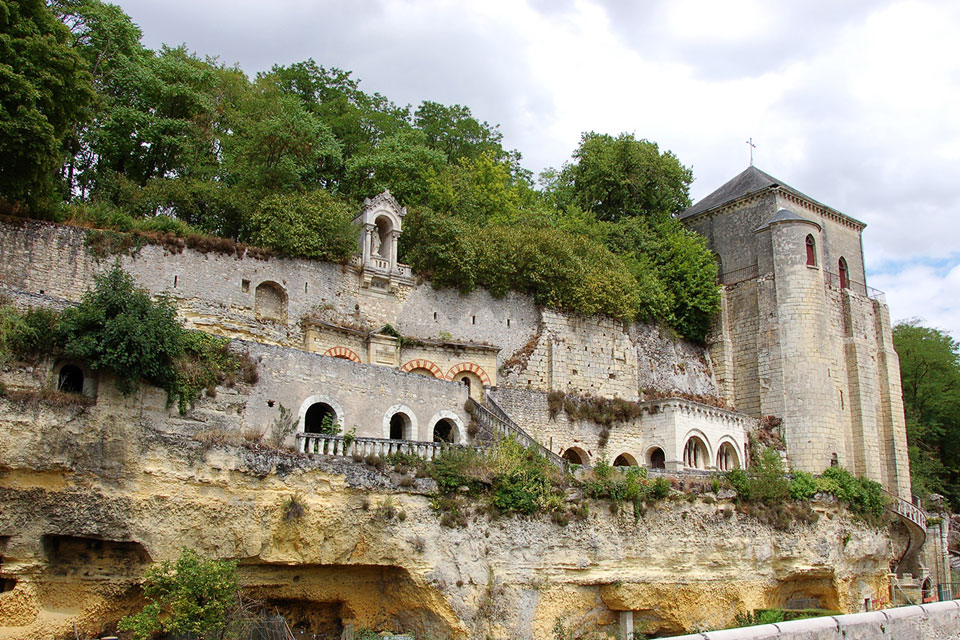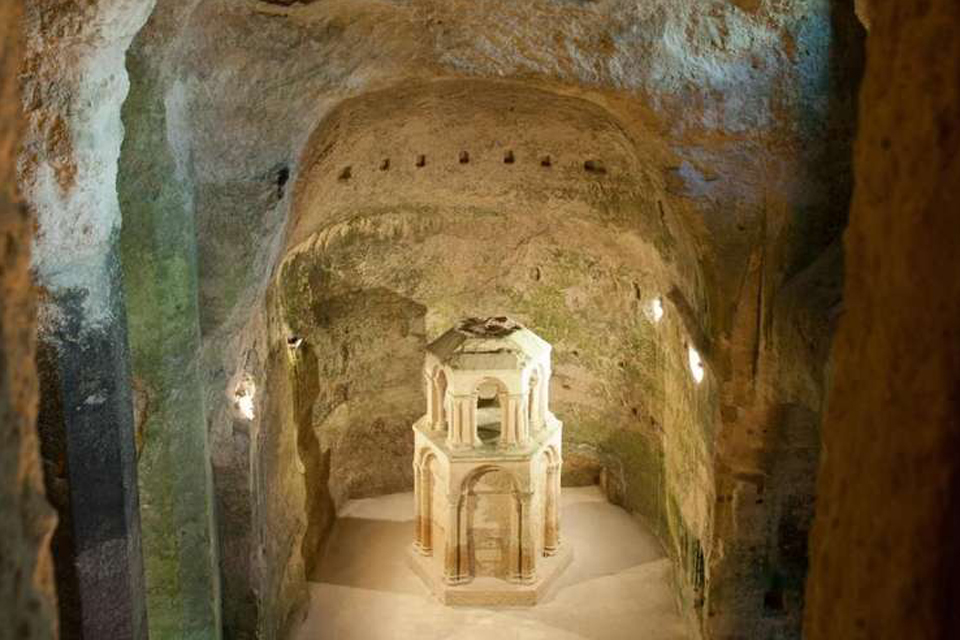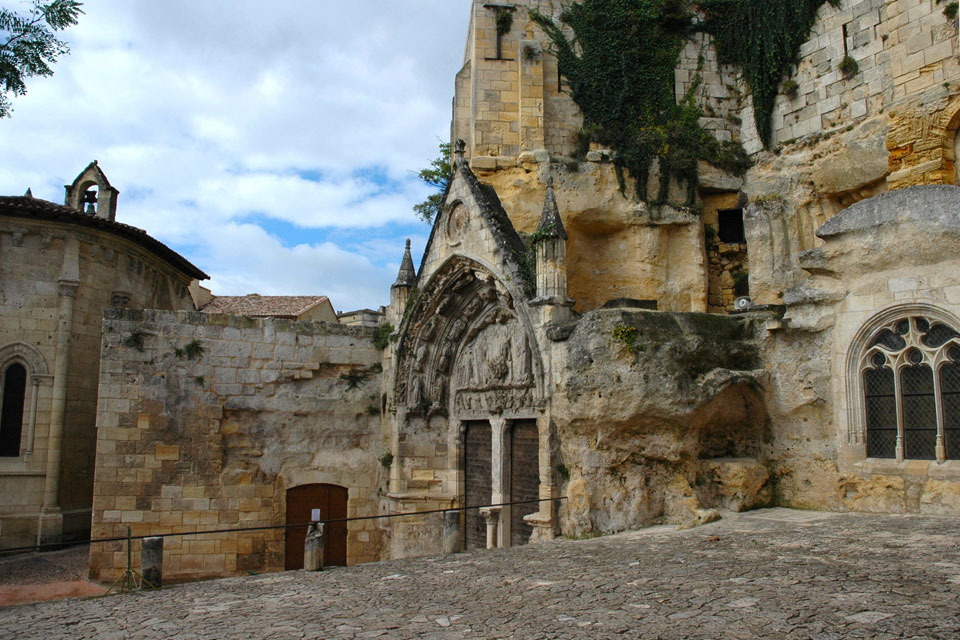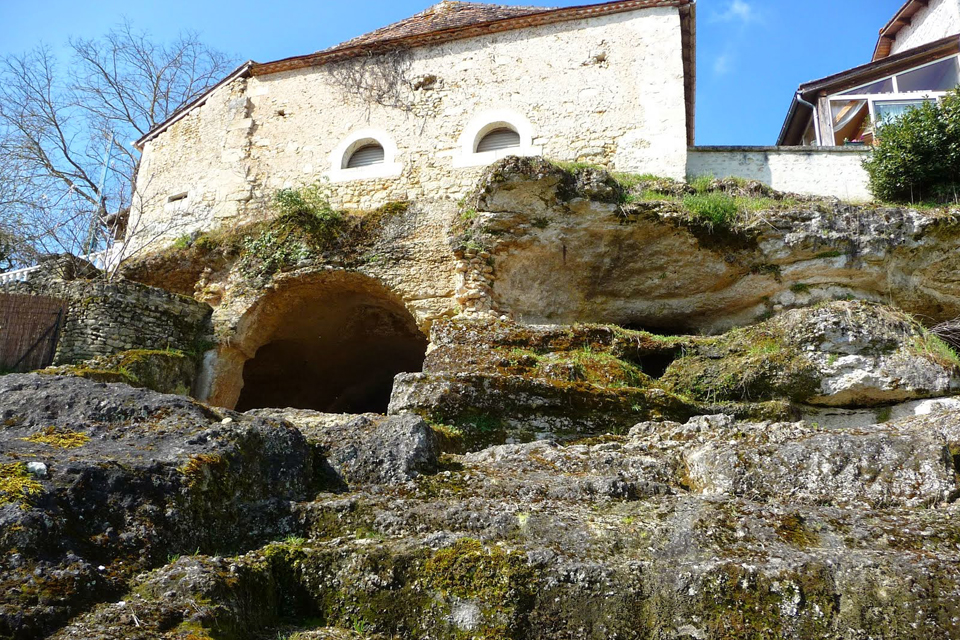Remains of rock-hewn churches may be found in several European and Middle-Eastern landscapes, where natural caves and calciferous rocks invited hermits to shelter in solitude and prayer. In France, such churches were common in Aquitaine.
Full alike of dignity and courtesy, Martin of Tours kept up the position of a bishop properly, yet in such a way as not to lay aside the objects and virtues of a monk. Accordingly, he made use, for some time, of the cell connected with the church but afterwards, when he felt it impossible to tolerate the disturbance caused by the numbers of those visiting it, he established a monastery for himself about two miles outside the city. This spot was so secret and retired that he enjoyed in it the solitude of a hermit. For, on one side, it was surrounded by a precipitous rock of a lofty mountain, while the river Loire had shut in the rest of the plain by a bay extending back for a little distance; and the place could be approached only by one, and that a very narrow passage. Here, then, he possessed a cell constructed of wood. Many also of the brethren had, in the same manner, fashioned retreats for themselves, but most of them had formed these out of the rock of the overhanging mountain, hollowed into caves. There were altogether eighty disciples, who were being disciplined after the example of the saintly master. No one there had anything, which was called his own; all things were possessed in common. It was not allowed either to buy or to sell anything, as is the custom among most monks. No art was practised there, except that of transcribers, and even this was assigned to the brethren of younger years, while the elders spent their time in prayer. Rarely did any one of them go beyond the cell, unless when they assembled at the place of prayer. They all took their food together, after the hour of fasting was passed. No one used wine, except when illness compelled them to do so. Most of them were clothed in garments of camels’ hair. Any dress approaching softness was there deemed criminal, and this must be thought the more remarkable because many among them were such as are deemed of noble rank.
Sulpicius, Vita, X – translation from Sulpicius Severus: On the Life of St. Martin. Translation and Notes by Alexander Roberts. In A Select Library of Nicene and Post-Nicene Fathers of the Christian Church, New York, 1894.

This description of the early Abbey at Marmoutiers near Tours founded in 371 helps us to understand the background for the rock-carved churches, which may still be visited in France. Albeit the Abbey began as a hermitage for St. Martin of Tours and his followers and was said to be primarily infused by the spirit of the “solitude of the desert”, it soon became a memorial shrine and a pilgrimage site. This may have taken off when the bishop of Volusianus of Tours constructed a rock-carved church, dedicated to St. John. Also, it appears, there was an ancient bridge across the Loire, built in the 1stcentury AD, which provided easy communion between the town and the abbey.
The exact layout of the Marmoutier of St. Martin of Tours is not known. Archaeological excavations, though, have shown a continued residence since late Antiquity.
Elsewhere, though, remains of similar hermitages, which were later turned into churches, pilgrimage centres and monasteries demonstrate the importance of these rock sanctuaries in late Antiquity. Albeit the exact date of these monuments escapes medieval historians, they nevertheless seem to offer an identical historical background. Asceticism continued to be en vogue and hermits continued to settle near local villages and settlements until the 12thcentury. Although in principle, solitaries, hermits tended to draw crowds of followers and admirers, and it is likely, this led to the diverse character of these places: some continued to be chapels in the wilderness, others turned into lively monastic centres. The three best preserved monolithic churches preserved can be found in the Aubeterre-sur-Dronne, Saint-Emilion and Gurat.
Aubeterre-sur-Dronne

One of the earliest preserved cave-churches in France stems from the early Middle Ages. For centuries, it was inaccessible due to a rock fall. Great was the amazement when it was rediscovered in the 50s. The sheer scale of the structure astounds any visitors. The height soars 27 metres, while the church measures 20 x 16 metres and includes a vestibule, a nave, a baptismal font, octagonal columns, a gallery and a precious reliquary carved as a replica of the holy sepulchre in Jerusalem.
The baptismal font is especially important since it was carved out of the rock in the form of a Greek cross, which dates it to the 4th– 9thcenturies. Also, at the end of the nave, a necropolis has been excavated which can be dated to late antiquity. However, the Romanesque church as it stands today reflects a construction from the 12thcentury. The splendid stone reliquary was originally created to house relics, which were brought home from Jerusalem by Pierre II de Castillon, crusader and lord of the castle in Aubeterre. These relics secured Aubeterre a slot on the pilgrimage route to Santiago.
The soaring height is marked out by the existence of the high gallery or triforium, which can be accessed by a staircase cut out of the rock. This gallery also served as an entrance to the church from above.
In Aubeterre-sur-Dronne is also a Romanesque church, the church of St Jacques which was also built to welcome pilgrims on the route to Santiago de Compostela. This has a wonderful 12th-century Romanesque facade with Moorish influence. It shows finely carved arches and some crumbling, yet gorgeous carvings on the capitals. The facade has a strong Moorish influence. The rest of the church was destroyed in the religious wars of the 16thcentury, and today only the facade remains. A walk up to the church following a dinner in the village is highly recommended
Aubeterre is built up from the river Dronne, offering a superb vista and the charm of being considered one of the most beautiful villages in France. At the foot of the village, where the meadows meet the River Dronne, are to be found a river beach and restaurant.
The Monolithic Church of Saint-Emilion

Saint-Emilion is, of course, best known for its vineyards, listed as UNESCO World Heritage in 1999. But it is also a charming medieval village housing the largest of the preserved rock-hewn churches, Saint Emilion. Carved out of limestone in the 12thcentury, it measures 38 in the length and is 12 meters high. Above ground a 53-meter high bell-tower raises. Also, the main entrance is fronted with an impressive gothic portal. Its three naves, with a small crypt beneath, is dedicated to Emillon, an 8thcentury Breton monk, who fled to escape persecution by the Benedictine Order. According to legend, he had been accused of theft. This led him on a long pilgrimage until he finally ended up in what later became the town named after him. Emillon, who adopted an eremitic existence, lived in a cave and was said to perform miracles. Later, he attracted a following of monks. Afterwards, the town acquired wealth and prominence due to its wine production and to its strategic position along a pilgrimage route to Santiago de Compostela.
In 1996 the edifice was severely threatened by water seeping in, undermining the bell-tower and closing off the monument for visitors. Recently though, restoration was finalized and the church was once more open for visitors. During the restoration, archaeologists found drainpipes, which had been installed by the monks to lead off the rainwater.
Next, to the church, a passage leads through the tourist office into the subterranean catacombs, where burial niches had been dug directly into the rock. Also, a passage through the Chapelle de la Trinité leads to what was later claimed to be the actual hermitage of Emillion.
Gurat – a monolithic church from the later Middle Ages

Located on a ridge overlooking the Lizonne valley through which the small river of Ronsenac runs below, visitors have to descend below the village of Gurat to enter the monolithic church. Moving inside, a series of seven grottos open up as well as the cave church itself. The entrance is through a passageway into an aisle, which measures 12 x 3,4 metres. With a height of 4,4 metres, it is fitted with an apse. The aisle is separated from the nave by two columns, hewn out of the rock and leading up to an apse-like structure, which probably held the remains of the founder of the church. Light streams from a small round window in the apsidal end of the aisle.
In 1967, Michael Gervers suggested that the church was constructed on a site containing numerous grottos, which had been “formed naturally by water erosion” and that a hermit at some point took up residence there. At some point, a community grew up around a hermit, which led to the construction of the cave church in the 13thcentury. Coin-finds and C14 dating have indicated that the church was last used as a shelter during the religious wars.
Recently, a study carried out by Jacqueline Meijer of the remains of 18 individuals buried outside the entrance of the cave has shown that it probably functioned as a monastic hostel. Based on strontium isotope analysis It was concluded that the eighteen individuals were born elsewhere but on average had lived at least five years at Gurat.
Recently, the cave church at Gurat was acquired by the village, which intends to restore it as a tourist venue. Until the 60s it was used as the village dump.
SOURCES:
The Cave Church at Gurat (Charente). Preliminary report
By Michael Gervers
In: Gesta, Vol 6, 1967
Exploring the Origins and Mobility of the Medieval Monastic Inhabitants of a Cave Church in Gurat, France, Using Strontium Isotope Analysis.
By Jacqueline Meijer
Unpublished thesis presented to the University of Waterloo, Master of Arts in Public Issues Anthropology.
Waterloo 2018
The post Rock-Carved Churches in France appeared first on Medieval Histories.
Powered by WPeMatico